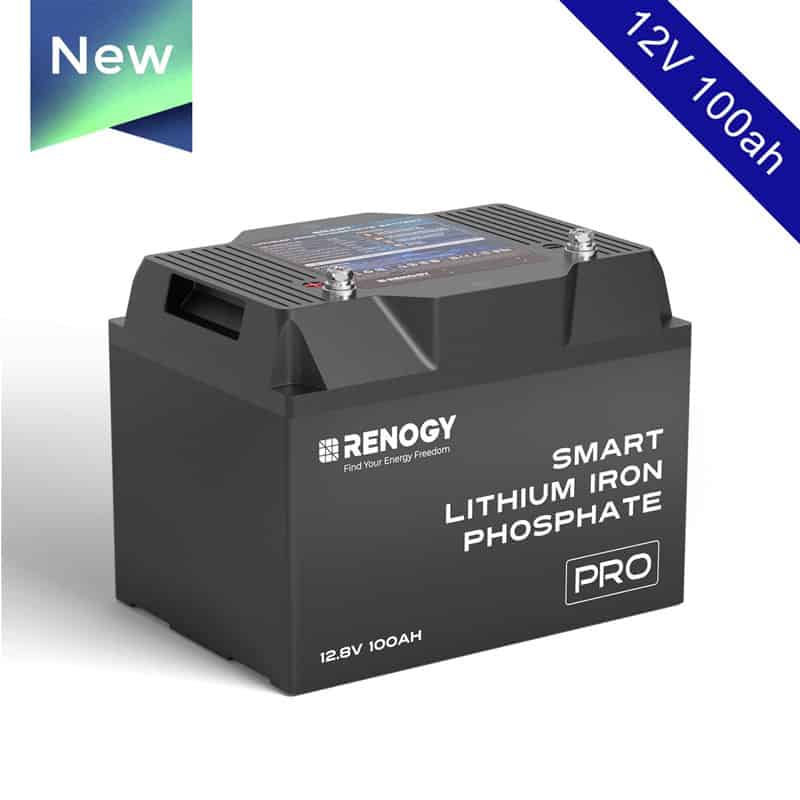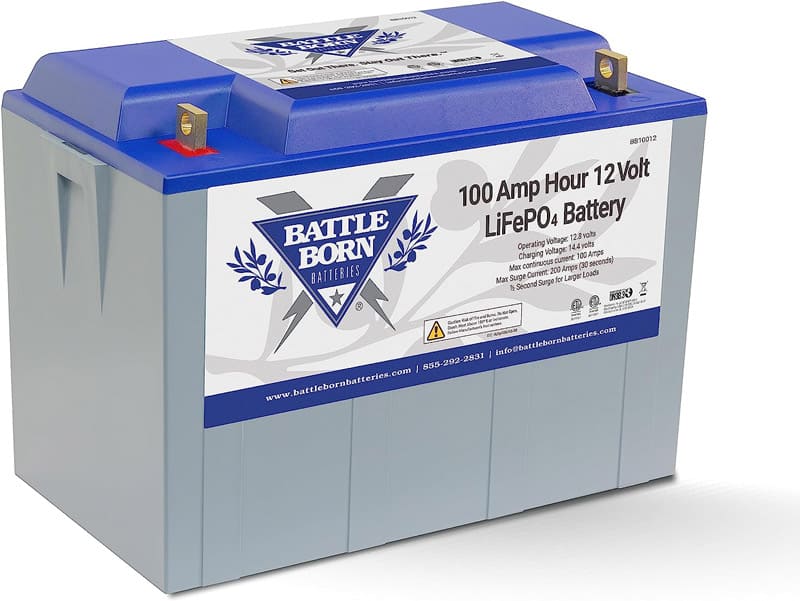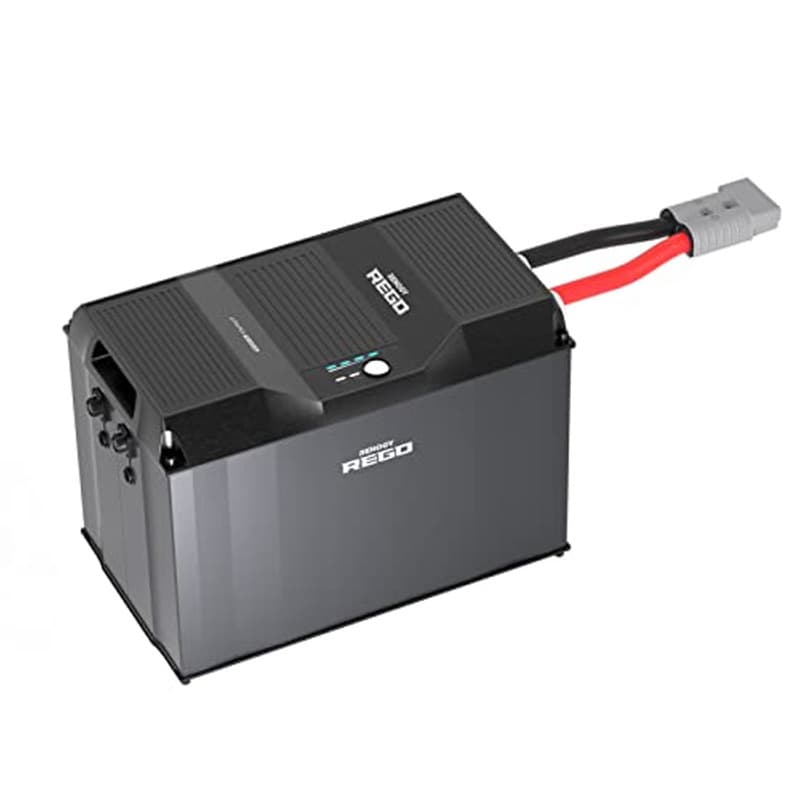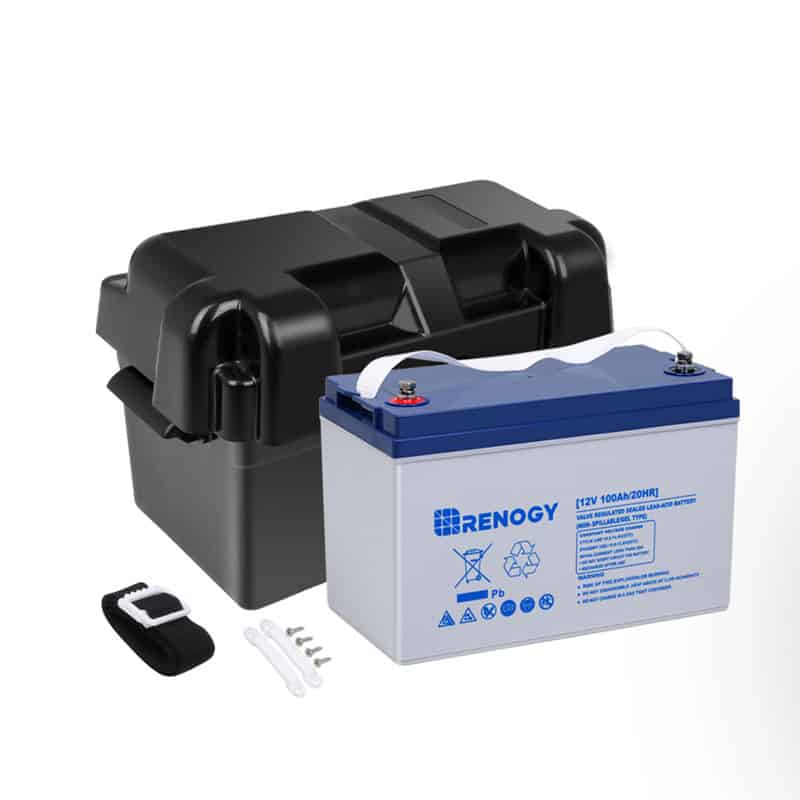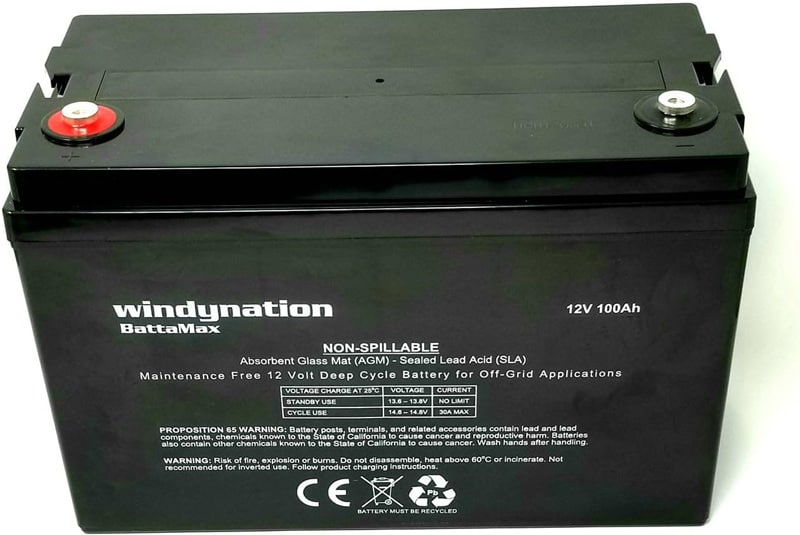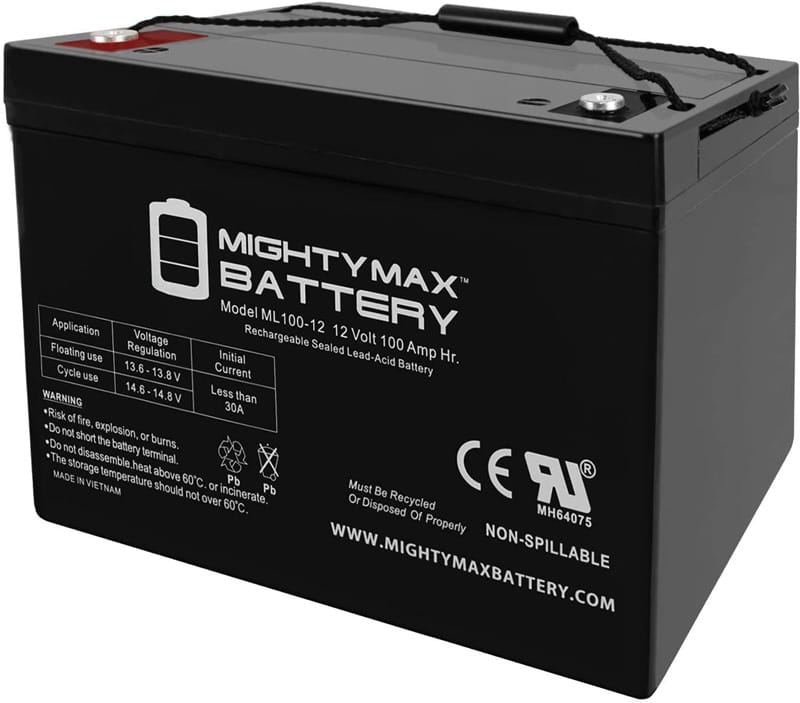Looking for the best battery for campervan conversion or upgrade? These are our top 6 picks for the best campervan batteries.
While living in various RVs over the past 4 years, we’ve learned that your house battery bank size is arguably the single most important part of your campervan electrical system.
In fact, aside from your water system, it may be the most important feature in your entire van conversion!
But finding the right battery can be as challenging as finding the right van to convert.
Determining how much battery capacity you need and whether you need multiple batteries for your battery system in your van conversion is no easy task.
And then, choosing between flooded lead-acid batteries, gel batteries, AGM batteries and lithium-ion batteries is difficult because they are each at different price points.
Fortunately, we’ve had both good and bad experiences with various sizes and battery types of campervan batteries.
We can help you understand which is the best battery for campervan living of all types and the criteria you should consider when setting up your battery bank.
Battery technology has improved drastically since we first set out on the road in 2008.
And while we only had a few deep cycle battery options then, now there are all sorts of house batteries from which to choose.
We’re not going to run you around ten or twelve different options to make you choose which is the best deep-cycle battery for your power storage needs. We’re going just to give you 6 of the best RV battery options for any van, motorhome or camper on the road.
And to get things started, let’s share our top pick as our Editor’s Choice for best camper van batteries.
Our Pick – Renogy Smart Lithium 100ah Battery
100 Ah Capacity
Durable and maintenance-free
Can discharge up to 80% and recharge in sub-freezing temperatures
| Product | Type | Capacity (Ah) | Weight (pounds) | Dimensions (inches) | Price Range |
| Renogy 100 Ah Smart Lithium | Lithium | 100 Ah | 27 pounds | 10.6×7.6×8.1 | Under $1,000 |
| Battle Born LifePO4 | Lithium-ion | 100 Ah | 29 pounds | 12.75×6.88×9 | Under $1,000 |
| Renogy Rego 400ah | Lithium-ion | 400 Ah | 112 pounds | 18×10.5×13 | Under $2,000 |
| Renogy 100aH Hybrid Gel | Hybrid Gel Battery | 100 Ah | 64 pounds | 12.9×6.8×8.7 | Around $200 |
| WindyNation 100aH AGM | AGM | 100 Ah | 66 pounds | 13×6.8×8.7 | Around $200 |
| Mighty Max SLA AGM | AGM | 100 Ah | 64 pounds | 12×6.63×8.29 | Under $200 |
Table of Contents
Best Battery for Campervan Living in 2024
Here is our shortlist for the best campervan batteries. We have assessed them on battery types, capacity, dimensions, battery lifespan and operating temperature range.
Note that each battery listed has a 100Ah battery capacity. These are the standard basic sizes for each of the brands listed. However, for each battery, you do have the option to purchase a 200 Ah battery.
These will have different dimensions and will be a little less expensive per Ah. But because the 100 Ah size is most common we wanted to give you the entry-level model.
Best Product // Our Top Picks at a Glance
Best Overall: Renogy Pro Smart Lithium Battery
This Renogy Smart Lithium battery is the best of the best designed for high-end operations.
Renogy has been an industry leader in solar and battery technology and we know firsthand that this battery delivers the exceptional performance that is to be expected from Renogy.
The Lithium technology gives it excellent discharge performance over standard AGM batteries. The battery has a self-discharge rate of only 3% per month at room temperature, which we found out as we stored ours for several months during our build.
Plus, the operating temperature range is great and unlike other competitors, the battery will function properly at sub-zero temperatures.
We really love that the Renogy Pro Smart Lithium battery is a leak-proof, maintenance-free battery with solid fire-resistant construction. It is entirely acid-proof and can handle the bouncing and vibrating that comes with life on the road.
The bluetooth connectivity as well is fantastic for keeping an eye on your system, even from the front of the cab.
On the downside, lithium campervan batteries, in general, aren’t cheap. But the price difference means you aren’t limited to AGM functionality such as only being discharged to around 60% of their capacity and relatively slow recharge rate.
Honestly, aside from that their price point is fantastic as a general house battery for any van build, and you can’t go wrong connecting two or more of these batteries together in parallel to create a solid lithium battery bank that is sure to meet all of your van life power storage needs.
PROS
- High discharge rate at low temperature.
- Maintenance-free and exceptional performer.
- Bluetooth connectivty.
- Flame-retardant casing.
- Waterproof, dust-proof and corrosion-resistant.
CONS
- Not as cheap as AGM
Affordable Lithium: Battle Born LifePO4 with Built-in BMS
- Price Range: Under $1,000
- Type: Lithium (LiFePO4)
- Capacity: 100 Ah
- Weight: 29 lbs
- Dimensions: 12.75 x 6.88 x 9 in
Battle Born Batteries is a trustable company based in Nevada. They have engineered the gold standard when it comes to building a lithium-ion RV battery bank.
The 100 Ah Lithium iron phosphate battery is one of the best on our list with far more pros than cons. If you can afford it, the lightweight battery is a perfect fit for the standard van electrical system that pairs up great with solar panels.
Unlike other deep-cycle batteries, you can run these batteries down to virtually nothing without permanently damaging them.
Plus they have a robust built-in battery management system (or “BMS”) that operates as the brain for the battery. It automatically cuts off the power when the battery is overcharging or overheating. It is a handy feature as it prevents the lithium battery from failing and unsafe operating conditions.
We really like that the four-cell LiFePO4 batteries are quite versatile. They only weigh 31 lbs which is at least 50% less than the average 100aH lead-acid battery.
It is a great option for small campervans because you can mount it in any position as there is no risk of acid leakage like in traditional lead-acid batteries. Moreover, it has 5,000 charge cycles ensuring an incredibly long and reliable life.
On the downside, the side panels are not quite rigid so you want to be sure to reinforce the area where you mount it. And Lifepo4 batteries do not handle freezing temperatures well. You can cause great damage to this battery if you attempt to charge it in subfreezing temperatures without battery kits to keep it warm.
But the battery does come with a 10-year warranty in the event you run into trouble.
PROS
- Lightweight and versatile.
- Can pump 200aH to jump-start big devices.
- Handy 10-year warranty.
- BMS protects the battery in unsafe conditions.
CONS
- Pricey
- Weak body structure
- Cannot charge in subfreezing temperatures
Best Lithium: Renogy Rego 400ah Battery
- Price Range: Under $2,000
- Type: Lithium (LiFePO4)
- Capacity: 400 Ah
- Weight: 112 lbs
- Dimensions: 18 x 10.5 x 13 in
The next level Renogy Rego 400ah Lithium Battery is the runner-up in this category, but not because it’s less of a system, because it’s way, way more!
Part of Renogy’s brand new plug-and-play Rego system, the 400ah lithium battery is an absolute beast and is by far our favourite setup on the market right now that is actually somewhat affordable.
With this much power you can literally go off-grid for over a week, running all your appliances in full comfort and have no problem at all.
The battery is designed for solar power, DC2DC and shore power when using the combiner box, making it a great camper van battery option.
The powerful battery has a minimum of 4,000 charge cycles that allow years or maybe up to a decade before needing a replacement.
Like other deep-cycle batteries, this one is not compatible with other brands. If you want more amp hours (but seriously, do you need more than 400ah??), you can connect multiple Renogy batteries in parallel.
Moreover, you can monitor the charge and discharge in real time through its separate monitor screen you to connect your smartphone via Bluetooth.
On the downside, this campervan battery type is generally prone to damage when charged at low temperatures. So you will want an internal battery compartment or heated battery kits to keep this lithium-ion battery bank operable.
We also don’t like that Renogy has started selling extended warranties on their products, but we have honestly never had a bad experience.
We’ve had to wait for hours on the phone and have sometimes gone days between email correspondence. But Renogy staff have always handled any issues or installation questions we’ve had with any Renogy product.
So why doesn’t it take the top spot, despite being bigger, better and faster to install?
Because for a lot of people, a comprehensive 400ah battery system is too much (and out of the budget).
Otherwise, if you can afford Renogy’s lithium campervan batteries you can’t go wrong with this Rego option!
PROS
- Massive amounts of power.
- Renogy’s Rego system is a simple plug-and-play option.
- Very reputable company
- Deep depth of discharge
CONS
- Customer service is not great.
- Not a great charge in subfreezing temperatures
Best Hybrid Battery: Renogy 12V 100 Ah Hybrid
- Price Range: Around $200
- Type: Hybrid Gel
- Capacity: 100 Ah
- Weight: 64 lbs
- Dimensions: 12.9 x 6.8 x 8.7 in
Hybrid gel batteries are an enhanced version of lead-acid batteries. Instead of lead acid, which is prone to boiling and leaking, they use special gel electrolytes. The Renogy deep cycle hybrid gel battery is efficient and has almost double the battery cycle than traditional lead batteries.
This deep-cycle battery is a maintenance-free battery that comes with advanced valve-regulated technology to ensure zero leakage. Moreover, a corrosion-resistant grid and 750 charge cycles significantly enhance the battery life.
While this is a drop in the bucket vs lithium options, it still exceeds standard FLA campervan batteries.
Unlike flooded batteries, the Renogy deep cycle hybrid battery is great for usable capacity. It has a long shelf life with low self-discharge. After many cycles, it will still discharge and charge like a new battery.
Moreover, patented gel electrolyte and proprietary plate composition ensure excellent recovery capability after excessive discharge. These hardy batteries can also produce 1000A discharge acting like starter batteries for 5 seconds to kickstart big things like a fridge and air conditioners.
Unlike Lifepo4 batteries, they can be connected in both series and parallel connections. But when doing so, it is recommended to use identical batteries.
Although it’s heavy, the Renogy deep cycle hybrid battery is a great option as a camper van battery. Due to its maintenance-free and leak-proof design, it does not emit any toxic gas and acid while charging on solar panels or shore power.
The downside of these batteries is that their price point makes it worthwhile to simply skip purchasing these to upgrade to an AGM battery.
Hybrid batteries are not so unique that they serve any specific functions as campervan batteries that are not unique to AGM or lithium. But they are definitely a step up from a standard FLA battery.
PROS
- Work with both series and parallel connections.
- Does not emit any harmful gas.
- Six sealing layers for safe charging.
CONS
- Pretty heavy.
- Nothing special about them
Runner Up AGM: WindyNation 100aH AGM Battery
WindyNation is among the best lead-acid batteries. This affordable battery is a great performer and a solid option for a campervan solar battery.
Unlike other cheaper options, WindyNation does not use recycled lead. The battery is made from 99.95% pure virgin lead. It is quite efficient and can bear hundreds and thousands of repetitive charges and discharges without compromising performance.
The heavy-duty battery has a long float life and a maintenance-free and sealed design. It can be used in extreme situations and can bear some wear and tear from off-roading.
Moreover, it can manage a wide range of temperatures while delivering optimal performance. And it comes with a relatively small one-year warranty in which you can refund or replace the battery.
On the downside, the exterior ABS plastic is not super firm, so avoid dropping the battery or putting pressure on its side. Also, the terminal connectors are small, so connecting wires to the batteries can be a bit of a challenge.
PROS
- Affordable.
- Made from pure virgin lead.
- Has a wide array of applications.
CONS
- The body is relatively weak.
- Connectors are small, so hooking them can be tricky.
Best Budget Battery: Mighty Max SLA AGM Battery for Solar Panels
Mighty Max batteries are among the most affordable AGM batteries. This 100 Ah battery is a solid product to keep all of your appliances in your van running.
Mighty Max has a robust, maintenance-free design with leak-proof construction. The sealed body does not require acid or water refills.
Its strong body is shock and vibration-resistant with a wide operating temperature range. The 100aH Mighty Max battery has a rapid discharge rate.
Installing the battery is straightforward, and it can be mounted in any orientation except upside down.
But on the downside, the mounting terminal screws may need to be upgraded to accommodate your loads or in some cases may not be included in the packaging. This battery is also heavy at 64 pounds.
PROS
- Long service life.
- A wide array of applications
- Durable maintenance-free design.
CONS
- Mounting accessories are not included in the box.
- Very Heavy
How to Choose the Best Battery for Campervan
Choosing the best campervan battery is not easy. They are available in a bunch of different configurations, types, capacities and budgets.
Replacement costs are not cheap if you select the wrong battery or push it beyond its intended purposes. So if you haven’t already decided on which deep cycle batteries would be best for your campervan, here is our expert guide to assist you in a buying decision.
Battery Purpose
You have two types of batteries inside your campervan and both are equally important but serve two distinctly different purposes.
Vehicle/Starter Battery
Starter batteries provide a jolt to start your van engine. These batteries are great for under-the-hood operation but not the right type to power appliances inside the van because most of their power is used to run the campervan’s engine.
For starter batteries, you don’t need deep-cycle batteries. But for your house battery bank, you will want to choose from any of the battery types recommended above.
House Battery or Leisure Battery
A house battery or leisure battery is the right product to power electrical appliances inside your camper van. They can be charged through solar panels or shore power and run appliances as long as you manage their capacity.
House batteries should be separated from starter batteries through the use of a battery isolator to keep them from discharging energy to the starter battery.
All of the batteries we recommend in this post are designed for use as leisure batteries.
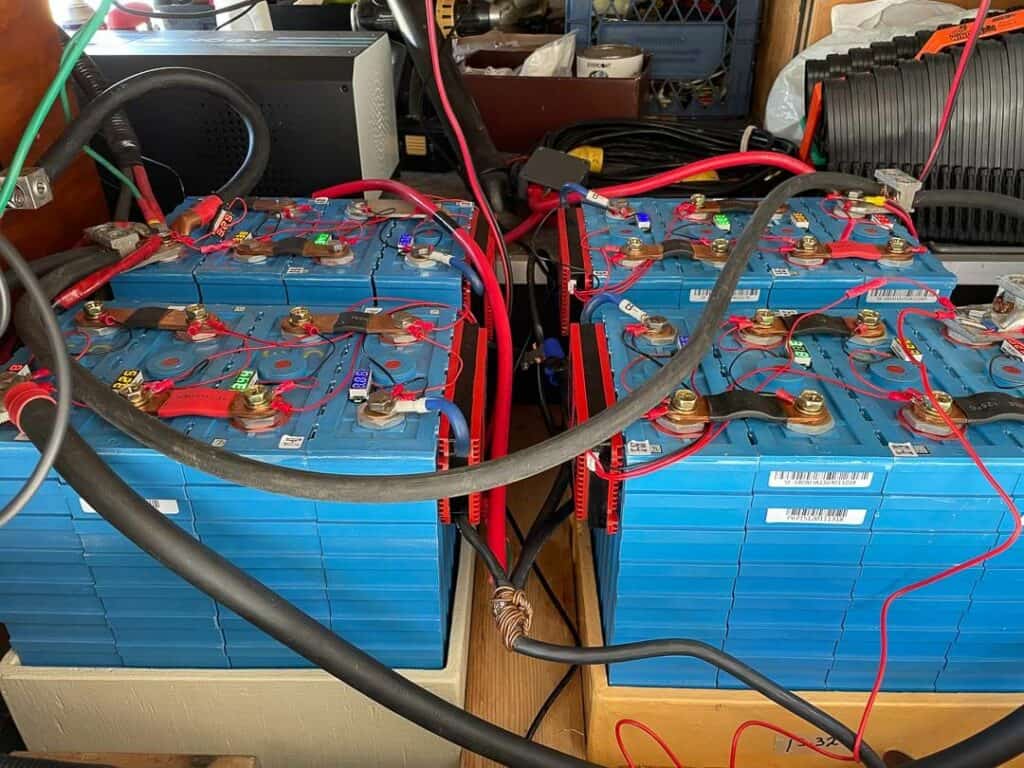
Types of Campervan Batteries
Before committing to building your house battery bank you’ll want to thoroughly review the pros and cons of each type of deep-cycle camper van battery. There are 4 types and each has its own advantages and disadvantages.
While we will briefly touch upon Flooded Lead Acid (FLA) batteries, we do not recommend them for use in your campervan as they can be dangerous when enclosed, require regular maintenance, and have a price point close enough to gel or AGM to make it worth upgrading.
Flooded Lead Acid Batteries
Flooded lead-acid batteries or FLA is the most common RV battery. They are cheap and have a relatively long life span. This type of battery has lead and liquid sulfuric acid that keep the batteries chemically charged.
Although it has a lower upfront cost, it can be expensive to maintain as you have to fill the batteries to the maximum level every month. Moreover, FLA can harm the van’s body because sulfuric acid can cause rusting. That’s why it must be stored in an upright position.
Moreover, it emits oxygen and hydrogen particles when charged. The particles are toxic if inhaled. So, proper ventilation is necessary.
NOTE: We don’t recommend FLA batteries in your camper van under any circumstance. They are too heavy, require ventilation and maintenance and will have issues bouncing around the backroads of van life.
Gel batteries
Hybrid batteries (gel) are an enhanced version of FLA batteries that are properly sealed, so there is no risk of toxic fumes and acid leaks. Instead of liquid water, the electrolytes are suspended in gel form, making them more stable and thus sealable.
However, gel cell batteries are comparatively expensive and have a lower output than flooded lead-acid batteries. Moreover, they need to be charged by a specific charger; otherwise, they can burn out.
Although hybrid batteries are a step above FLA batteries, we don’t recommend them either. We recommend that you consider either AGM or Lithium-ion batteries for your battery bank.
AGM Batteries
AGM deep cycle batteries also have sulfuric acid electrolytes soaked in an absorbent glass mat. This type of battery is also sealed and doesn’t discharge hazardous fumes. And you can connect these batteries in parallel and/or series as well.
AGM batteries are great options for camper van batteries because they have a deeper depth of discharge, down to 40% of the battery capacity and because they do not discharge gases they can be enclosed in tight spaces inside your van. You can also mount them in any orientation except upside down, which is handy in the small spaces of campervans.
They are also able to take a beating as you search for off-grid camping and unlike their lithium iron phosphate counterparts, they will charge and operate in colder weather without issue.
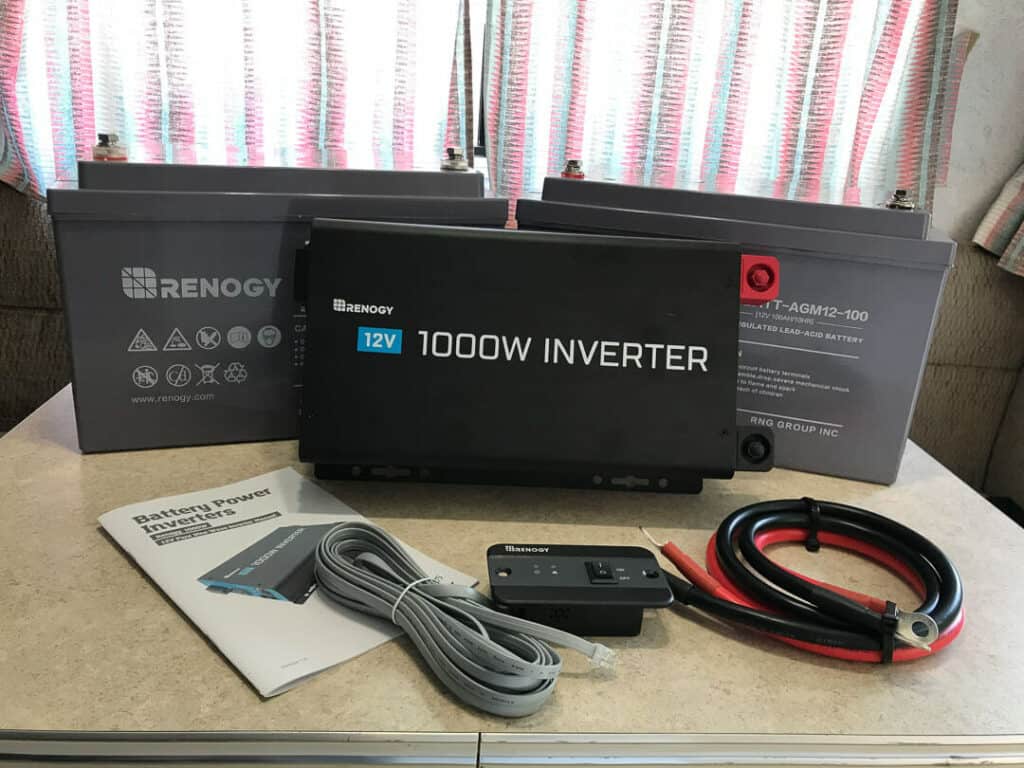
We recommend AGM batteries as great, affordable entry-level batteries for any campervan.
Lithium Batteries
Lithium iron phosphate (LiFePO4) batteries are the best type of campervan battery. The solid batteries are efficient and have the best power output among the mentioned types. Lithium batteries last longer, charge faster and do not require any maintenance.
However, the batteries are pretty expensive. Although prices are coming down pretty quickly, many campers have to leave the lithium battery option because their price can be 2-3 times more than a good AGM battery and 3-4 times that of a quality lead-acid battery.
Unlike their counterparts, they have their own battery management systems to monitor the battery chemistry inside the battery to prevent damage to the cells. And they have the greatest depth of discharge, down to nearly 0%, before they need to be recharged.
So unlike the other batteries on this list, lithium iron phosphate batteries are worry-free in the sense that you can discharge them at any level before recharging them. They also have exceptionally long lifespans capable of many thousands of charge cycles when regularly charged.
However, if you plan to camp in colder weather you will need to invest in heated battery kits or be very intentional about placing them inside your van where they will remain above freezing even in subfreezing temperatures. Charging lithium batteries in subfreezing temperatures can cause catastrophic damage to them.
If you can afford the higher price point, lithium batteries are by far the best option for your campervan. We recommend both our top pick and runner-up pick to ramp up your battery bank.
Battery Capacity (Ah)
Battery capacity is an important factor. The capacity is measured in amp-hours (Ah), which depicts the amount of power a battery can store on a single charge.
Before building your house battery bank, you must calculate approximately how many amp-hours you will use on a regular basis.
For example, a 1 amp LED light will consume 1 amp hour in an hour. A laptop may consume as much as 6 amps per hour while a vent fan might consume 3 amps per hour.
So if you were to fall asleep for 8 hours with one light, one computer charging and your fan you would use 1 + 6 + 3 = 10 amps for every hour. Multiple 10 amps times 8 hours and when you wake up you will have used 80 Ah.
This is a huge amount, relatively speaking, and is just for the sake of simplicity – not to scare you into purchasing too many batteries!
However, you should evaluate your daily power usage and select suitable batteries for your needs. We always recommend adding as much capacity as you can reasonably afford and fit into your campervan.
You can’t go wrong with too much battery bank capacity. But you can damage your batteries and find yourself inconvenienced with too little.
We recommend adding a great battery monitor to keep track of your battery state of charge to stay on top of proper capacity for whichever type of battery you choose.
Dimensions and Weight
The weight of the batteries can vary depending on the type and capacity. Flooded lead-acid and gel batteries are pretty heavy, with a 100 Ah battery weighing up to 70 pounds.
In contrast, similar lithium batteries weigh around 30 pounds. It is an important criterion because weight is always a consideration with anything you add to your campervan.
In terms of dimensions, there is not a big difference in the battery sizes. 100 Ah lithium batteries tend to be an inch slimmer than lead batteries.
Operating Temperature
Temperature can have a dire impact on the battery’s performance. AGM batteries have an operating range of -40F to 120F, which is quite good. You likely won’t find yourself anywhere outside of this range.
Although lithium batteries have a lot of qualities that make them arguably the best campervan batteries, the low end of their operating temperature range is an expensive weakness. They tap out at 32F and thus should not be used at or below freezing. But their upper range is normal for batteries, at 130F.
6 volts or 12 volts?
Typically campervan electrical systems run on 12V and thus you would want to install 12-volt batteries inside your van as they are cheap and easy to find.
At the same time, 6V batteries have more amperage when connected in series and have more charge cycles than standard 12V batteries. Moreover, they last longer and have thicker plates and deeper discharge.
You can connect two 6-volt batteries in series to create 12 volts. But be warned that many lithium batteries have limitations on how they can be connected in series or parallel.
Battery Lifespan
The battery is the most essential part of a campervan electrical system and it should bear the test of time. Different types of batteries have varying lifespans and the cost of replacement of some cheaper batteries makes it worthwhile to invest in more expensive, higher-quality batteries with longer lifespans.
Flooded Lead-acid batteries can last for four to eight years in ideal situations. But they require regular maintenance to come anywhere close to this.
Gel batteries have a life span of four to six years, which is quite limited. But you can stretch it a year or two by using the proper battery charger.
Although AGM deep cycle batteries do not need maintenance, they start losing capacity at the six-year mark.
Lithium batteries are the greatest. They have an average lifespan of a decade and can even last up to 20 years if adequately maintained.
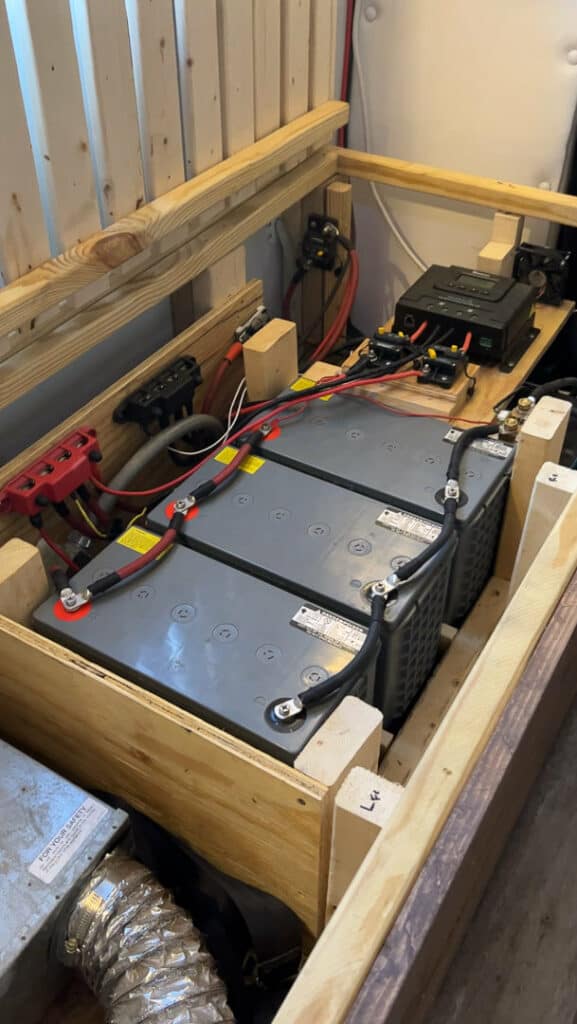
Series & Parallel Connections
When it comes to powering your campervan battery bank, sometimes you may want to connect multiple batteries to increase the amperage or voltage of the battery. When you do this, you can connect the batteries in series or parallel connections.
The series connection will increase the voltage while keeping the amperage the same. Thus two 6V 100amp-hours batteries connected in series would generate 12 volts at 100 Ah capacity. To make this connection you would connect the positive terminal of one battery to the negative of the other.
On the other hand, parallel connection doubles the amperage and is far more common in RV applications. By connecting the negative terminal to the negative and positive terminal to the positive, you can increase the amperage of two 12V 100aH batteries to 200-amp hours while maintaining the same power of 12 volts.
Wrapping Up
While shopping for your campervan battery can seem overwhelming, we hope we’ve made the process simpler and more straightforward for you. With all the options out there, you should evaluate how much power you think you will use on a regular basis and find the best possible battery you can afford.
Our Pick – Renogy Smart Lithium 100ah Battery
100 Ah Capacity
Durable and maintenance-free
Can discharge up to 80% and recharge in sub-freezing temperatures
All around we believe that this Renogy Smart Lithium 100 Ah battery is the best one on our list. The long-lasting battery can be mounted virtually anywhere, can take a beating from bumps and vibrations and can be discharged to 80% of its capacity.
Two or more of these connect in parallel wonderfully to double or triple the battery banks amp-hours leaving you with more than enough energy for all your van life needs.
The Renogy 100 ah lithium battery is an industry leader in terms of quality and efficiency. After bouncing around tens of thousands of miles with standard flooded lead-acid batteries we spent hours researching the best battery for an upgrade to our power system.
We came across these and haven’t looked back. They are sealed, so there is no maintenance or worries about tucking them out of the way.
DISCLAIMER: Some of the links in this article are affiliate links, which means if you book accommodation, tours or buy a product, we will receive a small commission at no extra cost to you. These commissions help us keep creating more free travel content to help people plan their holidays and adventures. We only recommend the best accommodations, tours and products that ourselves or our fantastic editorial team have personally experienced, and regularly review these. Thanks for your support, kind friend!

